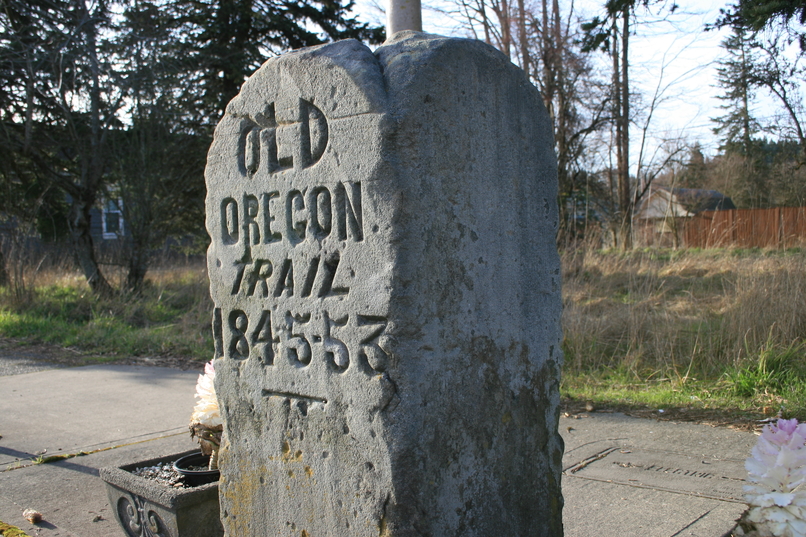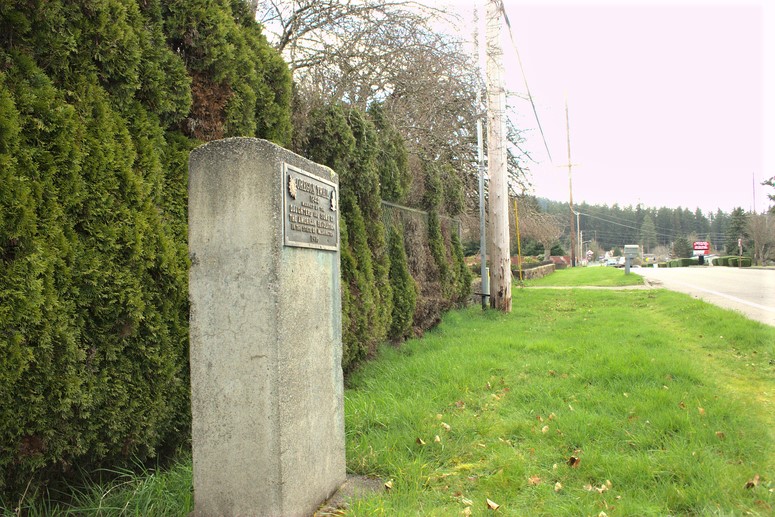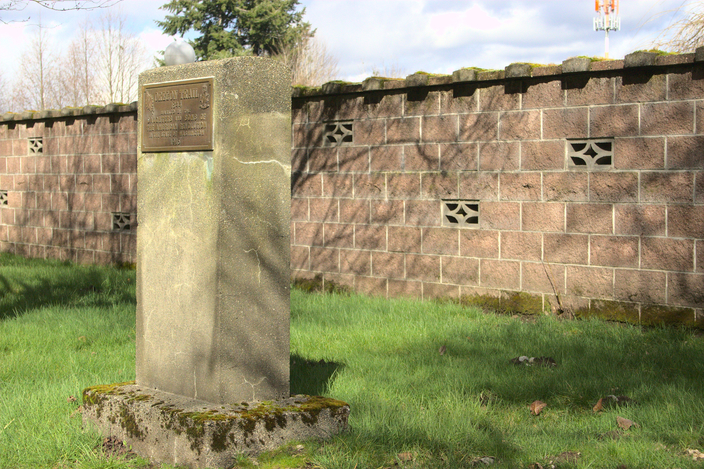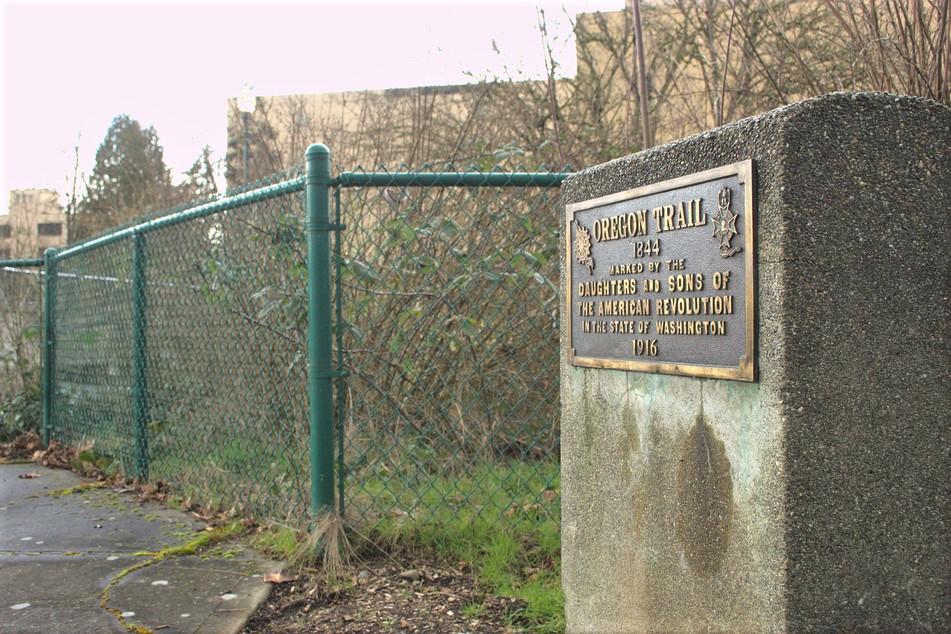IIf you’ve lived in the Pacific Northwest for a long time, chances are you’ve toured part of the Oregon Trail. Olympia is the end point of an estimated 2,000 mile hike west from various cities in Missouri. The Sacajawea chapter of the Daughters of the American Revolution placed markers from Vancouver, Washington to Olympia. So take a day trip to these Oregon Trail markers in Thurston County. (Please note that while markers were in open fields 100 years ago, they are now in narrow roadside locations.)
Tenino Trail marker
Although not placed by the DAR, the marking on the main road through Tenino begins the chronology of the remembrance of the paths. On February 12, 1906, a large part of the city celebrated the placement of the small monument together with Ezra Meeker. Shops in town closed and the children left school to attend the event. It is located on the northwest corner of Sussex Avenue, State Route 507, and Sheridan Street in Tenino. A rectangular block of sandstone cut by the nearby Tenino Quarry Company bears the simple inscription “Old Oregon Trail 1844-53”.
 The first trail marker is on the corner of Sussex Avenue and Sheridan Street in Tenino. It is a block of sandstone that was cut nearby by the Tenino Quarry Company. Photo credit: Rebecca Sanchez
The first trail marker is on the corner of Sussex Avenue and Sheridan Street in Tenino. It is a block of sandstone that was cut nearby by the Tenino Quarry Company. Photo credit: Rebecca Sanchez
The idea of marking and maintaining the path started with Ezra Meeker. In 1906, at the age of 75, Meeker, who had traveled the West himself for the first time, launched a campaign to raise awareness and secure federal protection funds. Meeker’s way of 1852 was cleared by land development. Settlers who bought land were now plowing and changing the site. Meeker began his pilgrimage in Puyallup and traveled east to set memorial markers. One of his early stops in Washington was in Tenino, where he laid the first inscribed stone.
 The Ezra Meeker marker is now in Tenino next to the 507 motorway. The commemoration ceremony on February 12, 1906 took place in what was then a small field. Photo courtesy of the Washington State Archives
The Ezra Meeker marker is now in Tenino next to the 507 motorway. The commemoration ceremony on February 12, 1906 took place in what was then a small field. Photo courtesy of the Washington State Archives
Tenino Scatter Creek Bridge marker
If you are retracing the Oregon Trail as you make your way from Grand Mound to Puget Sound, you must visit two monuments in Tenino. The second stop is the DAR marker near 420 Old Highway 99 across from Tenino Elementary School. It’s on the east side of the road, just south of the Scatter Creek Bridge. The importance of the place is the historic Hodgson Station. Stephen Hodgson settled the land for farming in 1851 and later became postmaster. As a junction for the journey from Grand Mound, which either continues east to Yelm or turns north towards Tumwater, the station was also a station for stagecoaches. The commemoration of this marker took place on September 10, 1916 at 2:30 p.m. The children were discharged from school and led the assembled crowd in a flag salute.
 The second trail marker in Tenino, set by the Daughters of the American Revolution, is at the historic site of Hodgson Station. It was Stephen Hodgson Farm and a stagecoach stop. Photo credit: Rebecca Sanchez
The second trail marker in Tenino, set by the Daughters of the American Revolution, is at the historic site of Hodgson Station. It was Stephen Hodgson Farm and a stagecoach stop. Photo credit: Rebecca Sanchez
Grand Mound marker
Grand Mound means where the Cowlitz portion of the Oregon Trail flows into what is now Thurston County. Here an easterly turn took and led travelers to Tenino and Bucoda. On the day of the commemoration of this marker, Governor Ernest Lister and honorary students from the State Girls’ School attended the celebrations. This marker is located at 20639 Old Highway 99 near Highway 12 and Grand Mound Way between two cedar trees west of Interstate 5. The inscription on the marker reads: “Oregon Trail 1844, marked by Daughters and Sons of the American Revolution in the State of Washington, 1916. “
Bush Prairie marker
On the same afternoon as the events near Tenino Elementary School, other students celebrated a newly placed marker several miles north. This marker is located at 8820 Old Highway 99 south of 88th Avenue on the east side of the highway. The significance of this place is the 668 acre farm of George and Isabella Bush, the first settled farm north of the Columbia River. George was the first black pioneer to own land in the Washington Territory. Settled in 1845, the farm was a well-known place of friendship and community support and is still operated today as Bush Prairie Farm. On September 10, 1916, the flag was hoisted and school children placed flowers at the foot of the new monument.
 George and Isabella Bush’s 668-acre farm was the first settlement north of the Columbia River. Settled in 1845, it was a well-known place of friendship and community support. It is still in operation today. Photo credit: Rebecca Sanchez
George and Isabella Bush’s 668-acre farm was the first settlement north of the Columbia River. Settled in 1845, it was a well-known place of friendship and community support. It is still in operation today. Photo credit: Rebecca Sanchez
Tumwater marker
The penultimate marker is on the southeast corner of Boston Street and Deschutes Way near Tumwater Falls Park. The importance of the place is in part the former home of Ira Ward. Ward, like the settlers who came before him, ran mills in this prime hydropower site. This marker was erected and remembered on August 18, 1916, and a quartet sang the “Stars and Stripes”. Kaplan and pioneer PD Moore said the invocation was in front of a crowd of about 600 people, including a number of pioneers. Four grandchildren of state pioneers officially accepted and unveiled the monument.
 This marker, placed by the Daughters of the American Revolution, Chapter Sacajawea, is located near Tumwater Falls Park. The importance of the place is in part the former home of Ira Ward. Ward, like the settlers who came before him, ran mills in this prime hydropower site. Photo credit: Rebecca Sanchez
This marker, placed by the Daughters of the American Revolution, Chapter Sacajawea, is located near Tumwater Falls Park. The importance of the place is in part the former home of Ira Ward. Ward, like the settlers who came before him, ran mills in this prime hydropower site. Photo credit: Rebecca Sanchez
Sylvester Park Marker, Olympia
The last marker is on the northwest corner of Sylvester Park in Olympia, on Legion Way and Capital Boulevard. The inscription on this indigenous granite block reads: “Marks the end of the Oregon Trail 1844.” The significance of the location is the exact location of a wooden log cabin that served as a safe haven during the conflicts between 1855 and 1856. The park itself, which was donated by Olympia founder Edmund Sylvester in 1850, has been designated as a common room. According to federal maps, the path actually ended here. Five hiking trails from east to west: from Vancouver to Toledo to Olympia; from Olympia to Puyallup to Blain. All of them branched off the transcontinental Oregon Trail. On February 22, 1913, the DAR commemorated the marking. Ezra Meeker spoke again at the trail marking event.
Much of this trail became Pacific Highway 99. The paving began in 1913 when the Sylvester Park marker was laid. This day trip takes you the pristine trails of the Oregon Trail, perhaps in an SUV station wagon rather than a covered prairie wagon. If you look into a clear sky, you may notice the planes following the same path above.



